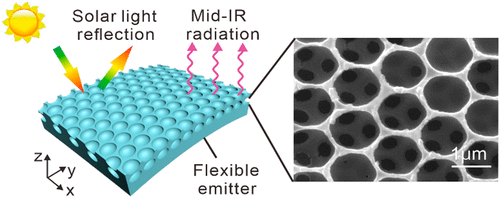当前位置:
X-MOL 学术
›
ACS Photonics
›
论文详情
Our official English website, www.x-mol.net, welcomes your
feedback! (Note: you will need to create a separate account there.)
Flexible Polymer Photonic Films with Embedded Microvoids for High-Performance Passive Daytime Radiative Cooling
ACS Photonics ( IF 6.5 ) Pub Date : 2021-10-20 , DOI: 10.1021/acsphotonics.1c01149 Lei Zhou 1 , Jintao Zhao 1 , Haoyun Huang 1 , Feng Nan 1 , Guanghong Zhou 1 , Qingdong Ou 2
ACS Photonics ( IF 6.5 ) Pub Date : 2021-10-20 , DOI: 10.1021/acsphotonics.1c01149 Lei Zhou 1 , Jintao Zhao 1 , Haoyun Huang 1 , Feng Nan 1 , Guanghong Zhou 1 , Qingdong Ou 2
Affiliation

|
Passive radiative cooling, a promising strategy for energy savings and sustainability, enables cooling of the ambient temperature by synchronously reflecting sunlight and dissipating heat to the ultracold outer space through the atmospheric transparency window. While designed photonic structures have shown intriguing passive radiative cooling performance, the implementation of such photonic radiators remains challenging due to complex nanoscale lithography/synthesis and rigidity. Here, we experimentally demonstrate a simple and versatile approach of fabricating flexible polydimethylsiloxane radiator thin films with built-in three-dimensional microvoid (inverse-opal-like) arrays for highly efficient daytime radiative cooling. The microvoid-embedded polymer radiator film with tailored spectral responses shows an optimized total reflectivity of ∼93.4% in the sunlight region and a strong infrared emissivity of ∼94.6% within the atmospheric window, respectively. Through such remarkable solar reflection and infrared thermal radiation, the structural polymer radiator achieves subambient cooling of ∼9.8 °C during the night and ∼5.8 °C under direct sunlight in a nonvacuum setup. The three-dimensionally embedded microvoid arrays in our engineered photonic polymer films efficiently backscatter the incident solar radiation and simultaneously enhance the absorption/emissivity in mid-infrared wavelengths, leading to continuous subambient all-day cooling. Our findings provide an effective pathway toward a low-cost, high-performance flexible photonic radiative cooler for passive daytime cooling.
中文翻译:

具有嵌入式微孔的柔性聚合物光子膜,用于高性能被动日间辐射冷却
被动辐射冷却是一种很有前景的节能和可持续性策略,它通过同步反射阳光和通过大气透明窗将热量散发到超冷的外层空间来冷却环境温度。虽然设计的光子结构已显示出有趣的被动辐射冷却性能,但由于复杂的纳米级光刻/合成和刚性,这种光子散热器的实施仍然具有挑战性。在这里,我们通过实验证明了一种简单而通用的方法来制造具有内置三维微孔(反蛋白石样)阵列的柔性聚二甲基硅氧烷散热器薄膜,用于高效的白天辐射冷却。具有定制光谱响应的微孔嵌入聚合物辐射膜显示优化的总反射率约为 93。太阳光区域为 4%,大气窗口内的强红外发射率约为 94.6%。通过如此显着的太阳反射和红外热辐射,结构聚合物散热器在夜间实现了约 9.8°C 的低温冷却,在非真空设置中在阳光直射下实现了约 5.8°C 的低温冷却。我们工程光子聚合物薄膜中的三维嵌入微孔阵列有效地反向散射入射的太阳辐射,同时增强中红外波长的吸收/发射率,从而实现全天持续的低温冷却。我们的研究结果为用于被动白天冷却的低成本、高性能柔性光子辐射冷却器提供了有效途径。通过如此显着的太阳反射和红外热辐射,结构聚合物散热器在夜间实现了约 9.8°C 的低温冷却,在非真空设置中在阳光直射下实现了约 5.8°C 的低温冷却。我们工程光子聚合物薄膜中的三维嵌入微孔阵列有效地反向散射入射的太阳辐射,同时增强中红外波长的吸收/发射率,从而实现全天持续的低温冷却。我们的研究结果为用于被动白天冷却的低成本、高性能柔性光子辐射冷却器提供了有效途径。通过如此显着的太阳反射和红外热辐射,结构聚合物散热器在夜间实现了约 9.8°C 的低温冷却,在非真空设置中在阳光直射下实现了约 5.8°C 的低温冷却。我们工程光子聚合物薄膜中的三维嵌入微孔阵列有效地反向散射入射的太阳辐射,同时增强中红外波长的吸收/发射率,从而实现全天持续的低温冷却。我们的研究结果为用于被动白天冷却的低成本、高性能柔性光子辐射冷却器提供了有效途径。我们工程光子聚合物薄膜中的三维嵌入微孔阵列有效地反向散射入射的太阳辐射,同时增强中红外波长的吸收/发射率,从而实现全天持续的低温冷却。我们的研究结果为用于被动白天冷却的低成本、高性能柔性光子辐射冷却器提供了有效途径。我们工程光子聚合物薄膜中的三维嵌入微孔阵列有效地反向散射入射的太阳辐射,同时增强中红外波长的吸收/发射率,从而实现全天持续的低温冷却。我们的研究结果为用于被动白天冷却的低成本、高性能柔性光子辐射冷却器提供了有效途径。
更新日期:2021-11-17
中文翻译:

具有嵌入式微孔的柔性聚合物光子膜,用于高性能被动日间辐射冷却
被动辐射冷却是一种很有前景的节能和可持续性策略,它通过同步反射阳光和通过大气透明窗将热量散发到超冷的外层空间来冷却环境温度。虽然设计的光子结构已显示出有趣的被动辐射冷却性能,但由于复杂的纳米级光刻/合成和刚性,这种光子散热器的实施仍然具有挑战性。在这里,我们通过实验证明了一种简单而通用的方法来制造具有内置三维微孔(反蛋白石样)阵列的柔性聚二甲基硅氧烷散热器薄膜,用于高效的白天辐射冷却。具有定制光谱响应的微孔嵌入聚合物辐射膜显示优化的总反射率约为 93。太阳光区域为 4%,大气窗口内的强红外发射率约为 94.6%。通过如此显着的太阳反射和红外热辐射,结构聚合物散热器在夜间实现了约 9.8°C 的低温冷却,在非真空设置中在阳光直射下实现了约 5.8°C 的低温冷却。我们工程光子聚合物薄膜中的三维嵌入微孔阵列有效地反向散射入射的太阳辐射,同时增强中红外波长的吸收/发射率,从而实现全天持续的低温冷却。我们的研究结果为用于被动白天冷却的低成本、高性能柔性光子辐射冷却器提供了有效途径。通过如此显着的太阳反射和红外热辐射,结构聚合物散热器在夜间实现了约 9.8°C 的低温冷却,在非真空设置中在阳光直射下实现了约 5.8°C 的低温冷却。我们工程光子聚合物薄膜中的三维嵌入微孔阵列有效地反向散射入射的太阳辐射,同时增强中红外波长的吸收/发射率,从而实现全天持续的低温冷却。我们的研究结果为用于被动白天冷却的低成本、高性能柔性光子辐射冷却器提供了有效途径。通过如此显着的太阳反射和红外热辐射,结构聚合物散热器在夜间实现了约 9.8°C 的低温冷却,在非真空设置中在阳光直射下实现了约 5.8°C 的低温冷却。我们工程光子聚合物薄膜中的三维嵌入微孔阵列有效地反向散射入射的太阳辐射,同时增强中红外波长的吸收/发射率,从而实现全天持续的低温冷却。我们的研究结果为用于被动白天冷却的低成本、高性能柔性光子辐射冷却器提供了有效途径。我们工程光子聚合物薄膜中的三维嵌入微孔阵列有效地反向散射入射的太阳辐射,同时增强中红外波长的吸收/发射率,从而实现全天持续的低温冷却。我们的研究结果为用于被动白天冷却的低成本、高性能柔性光子辐射冷却器提供了有效途径。我们工程光子聚合物薄膜中的三维嵌入微孔阵列有效地反向散射入射的太阳辐射,同时增强中红外波长的吸收/发射率,从而实现全天持续的低温冷却。我们的研究结果为用于被动白天冷却的低成本、高性能柔性光子辐射冷却器提供了有效途径。











































 京公网安备 11010802027423号
京公网安备 11010802027423号